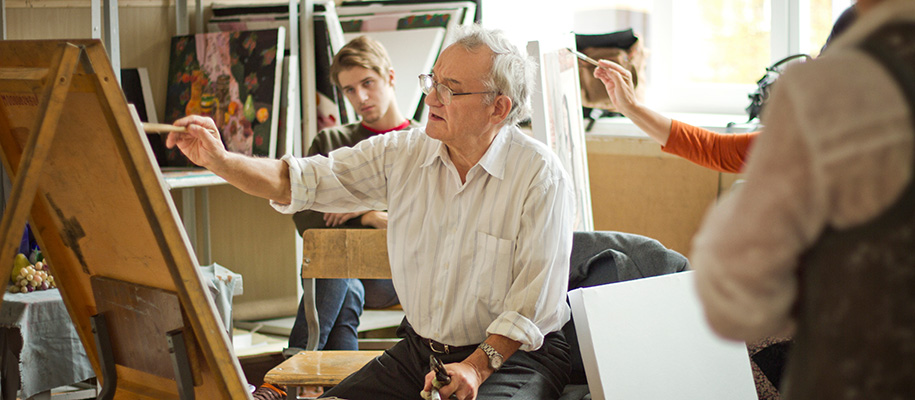There’s a plethora of advice out there to prepare you for your everyday college classes like biology, algebra, and English. All those courses with the expectations of typical studying, testing, and the occasional pop quiz. When it comes to college art classes, however, it’s a different story. Most studio art classes in college have projects instead of tests and easels instead of desks, so how can you ready yourself for this whole new experience? Whether you’ve taken art for years in high school or are stepping into your first-ever class, here are the basics of what you should know.
Studio and 2D art classes
These are what most students picture when they think of “art class.” Typically, these courses will center around a specific topic or artistic medium (or a variety of media if it’s an intro or overview class). For example, you might learn painting or ceramics and focus on projects that will help you master that concept. Your final will usually be one large project or simply whatever the last project is that you have time to cover. In one art class at my college, we had to complete a certain number of pieces by the midterm and end of the year to pass. It’s a lot of work, but there are few things as beautiful as having one less final paper exam.
My college art classes involved both individual and group critiques, where my professor and peers gave constructive criticism of my work. These critiques can feel downright terrifying at first, but after a few times, you get thicker skin and learn to separate yourself from your work. Everyone wants to help you improve, not tear you down! If you get individual critiques, you usually do not meet as a class, and instead, the professor will give you time to come by during their office hours.

What to expect from a typical class day
Generally, any course that involves in-class work will take longer than an average lecture class. My classes typically lasted an hour and a half or longer, but you do get breaks. Here’s what a typical day in one of my 2D art classes looked like:
- 1:30 pm: Everybody in class is at their chosen tables, which are kind of like huge desks with stools to perch on instead of chairs. This setup will differ by school and by classroom; sometimes you’ll need to share tables, and sometimes you’ll get an awesome art desk to yourself.
- 1:30–1:45 pm: The professor gives a brief lecture on a topic such as the principles of art, the use of charcoal, what he expects out of our next project, etc. We usually get handouts if there’s anything we’ll need to remember. Occasionally instead of a lecture, you might have a brief critique session, where each student presents their work and everyone offers suggestions and comments.
- 2:00–3:00 pm: We start working on our project. Usually, there’s music playing, and all kinds of weird conversations pop up, from the best restaurants in the city to what our parents were like in the ’80s.
- 3:00 pm: Time to get out of here! Although to be honest, it’s rare for art classes to end promptly; it depends on the professor, how much you need to get done in class, and where you're leaving off on the project you're working on.
How to come to 2D art class prepared
Make sure you have all your required materials ready for class. I’ve found that having a handful of other things—like scissors, tape, and a spare pencil—is a lifesaver when unexpected artistic emergencies arise! Also, try to remind yourself not to compare your work with your classmates’ work. Everyone progresses at different speeds in art, and you never know how someone approaches their art.
When it’s time to critique one of your fellow student artist's work, try to look for the good in a piece and make sure you word your comments kindly and tactfully. If you’re on the receiving end, feel free to ask clarifying questions if you need to, but never argue with critique directed at your piece. I have never felt the need to justify my choices. Usually, the feedback will teach me something, even when I don’t immediately need to apply it.
Related: How to Stay on Top of Homework as an Art Major
Graphic design classes
Since graphic design is my primary major, these classes are my favorites! These classes last about as long as studio classes because you’ll be doing in-class work as well. Depending on your college’s program, early-level classes may start with 2D principles like gridding and involve work with pen and paper, but before long you'll end up on a computer. If you’re working in 2D, the classroom setting will probably be a lot like a studio art class, but if you’re working on computers, then you’ll be in the computer lab. Our lab is set up with a huge smart board in front of the desks, so our professor usually shows us examples or gives demonstrations when we learn new topics. Labs also mean computers pre-loaded with graphic design software like Adobe Creative Suite, which includes Photoshop, Illustrator, and InDesign. Once you get into upper-level courses, you may also be working with Motion, but this depends on your college’s curriculum.
Peer critiques are also a large part of graphic design classes, with both individual and in-class reviews. Just like in your studio art classes, your grades will usually be based on projects rather than tests, but you may be quizzed on basic graphic design terms or principles. Sometimes, you may even get to watch cool design documentaries in class when not working on a project. One of my graphic design courses also required reading at least one article about design per week, but that type of assignment will depend on your professor. What to expect from a typical class day

What to expect from a typical class day
Here’s another look at a typical class period for graphic design:
- 8:30 am: That’s right—this is an 8:30 am art class. I endured and so must you too because inevitably you will have an 8:00 am. Everyone arrives on time (and sometimes with Chick-fil-A).
- 8:30–9:00 am: The professor gives a brief explanation of our current project, shows some examples, gives a tutorial, or just provides an overview of what our week will look like. If we’re doing peer critiques, we’ll post our printed works on the board and present them. Usually, it’s a plus if you note what font you’re using, the reason behind your color choices, and any other important notes to showcase your intentional thought process.
- 9:00–9:10 am: A short break for snacks or water before we dive in. (Those of us who didn’t get Chick-fil-A are wondering if we can make it there in time.)
- 9:10–10:30 am: We work at our computers on the day's projects. Usually, the professor will come around and offer specific advice to us each in turn, or be available to answer questions.
- 10:30 am: Breakfast time at long last!
How to come to graphic design prepared
We always had several days of tutorials before beginning work in a new design program, but I would highly recommend playing with the Adobe Creative Suite before this class and practicing outside of class if you want to be a graphic designer. It makes the process way smoother in class and gives you a head start when you begin your projects.
Also, look into what kind of computers are used in your school’s lab. If you’re accustomed to a PC and will be working on a Mac (as most design programs use Macs), it’s a good idea to familiarize yourself with the setup and any shortcodes/shortcuts that may help you. Your professor or your friendly neighborhood lab assistant might be able to point you in the direction of a computer you can rent or borrow from the school if you don't have access to one.
Related: 5 Simple Reasons You Should Get an Arts Degree
Art history classes
This class will be structured more like your prerequisite classes. There will be memorizing, tests, and a folder filled with Quizlet decks, but in my experience, these classes are more fun than your typical history courses. My Intro to Art History class required a trip to an art museum, and I’ve heard of art history classes that are almost entirely gallery-hopping—and sometimes even involve studying abroad! Typically, art history will be held in a normal classroom or lecture hall. You’ll view slide presentations, listen to lectures, and take notes just like you would in any class, except you’re learning about art. And that makes it cooler, right?
Make sure to look into who your professor is beforehand because it’s important to find someone whose teaching style best aligns with your learning style. If you’re a hands-on, visual learner, odds are you’ll do best with someone who has you create art in the classroom and sends you on field trips to experience art “in the wild.” If you prefer the classic lecture experience, look for someone who focuses more on exploring the detailed histories of art—artistic movements, particular artists, etc. You may even find, like my art history class, a lovely blend of the two.

What to expect from a typical class day
I bet you can guess what these classes looked like, but here’s yet another schedule example from one of my classes. This was a once-a-week night class for me, so that's why it’s super long. Classes on a standard, three-times-a-week schedule would be more spread out.
- 6:00–6:20 pm: We dive right in. The professor does roll call then gives us a schedule for the evening. If we’re doing presentations, the first group will come up and show us their slides. Presentations for my class weren't that hard to create, and pretty fun when you enjoy public speaking.
- 6:20–7:30 pm: Lecturing time! Usually, the professor includes some interesting diversions in between long explanations, like discussing what kind of person an art museum would be or comparing two works of art. Then, we run through some slides on his lecture presentation.
- 7:30-8:45 pm: Time for something hands-on. We usually have group projects to work on where we create some little art form inspired by the lessons—as this is an intro to art history class, they’re graded on effort, not so much craft.
- 8:45 pm: Typically, we wrap up with an overview of what’s due over the week, and sometimes an online quiz will go up that night that will be due by the next class period.
How to come to art history prepared
As previously mentioned, look into who the professor is and be ready for that person’s style of teaching. Will you need a certain type of binder to take notes or can you use your laptop? Will any activities require supplies? I actually needed to use my phone in class before—and, yes, it was sanctioned! Usually, these things will be covered on syllabus day, though, so the main thing is to not stress.
Related: Unique Careers for Visual Arts Students to Consider
College art classes are definitely a new experience, but it’s their differences from traditional college courses that make them so much fun—and that teach you important skills for adapting to new environments. No matter what, your art class will add some much-needed color to the rest of your schedule, and with a little luck they'll be the highlight of your week!
Haven't found your arts program yet? Explore awesome schools for your artistic future with our featured visual arts colleges lists!






